Measuring the Multiple Functions and Tradeoffs among Streets: A New Framework Using the Deep Learning Method
Abstract
:1. Introduction
2. Materials and Methods
2.1. Study Area
2.2. Measurement of Multiple Street Functions
2.2.1. Landscape Function
2.2.2. Traffic Function
2.2.3. Economic Function
2.2.4. Tradeoff Measurement
3. Results
3.1. Multifunctional Spatial Differentiation of Streets
3.1.1. Street Landscape Function
3.1.2. Street Traffic Function
3.1.3. Street Economic Function
3.2. Tradeoffs between the Multiple Street Functions
4. Discussion
4.1. Multifunctional Perspective
4.2. Policy Suggestions
4.3. Correlation of the Multiple Functions
5. Conclusions
Author Contributions
Funding
Data Availability Statement
Conflicts of Interest
References
- Chin, M.H.; King, P.T.; Jones, R.G. Lessons for achieving health equity comparing Aotearoa/New Zealand and the United States. Health Policy 2018, 122, 837–853. [Google Scholar] [CrossRef] [PubMed]
- Lu, Y. Using Google Street View to investigate the association between street greenery and physical activity. Landsc. Urban Plan. 2019, 191, 103435. [Google Scholar] [CrossRef]
- Vries, S.D.; Dillen, S.V.; Groenewegen, P.P.; Spreeuwenberg, P. Streetscape greenery and health: Stress, social cohesion and physical activity as mediators. Soc. Sci. Med. 2013, 94, 26–33. [Google Scholar] [CrossRef] [PubMed]
- Rundle, A.G.; Bader, M.D.; Richards, C.A.; Neckerman, K.M.; Teitler, J.O. Using Google Street View to audit neighborhood environments. Am. J. Prev. Med. 2011, 40, 94–100. [Google Scholar] [CrossRef] [PubMed]
- Borin, M.; Passoni, M.; Thiene, M.; Tempesta, T. Multiple functions of buffer strips in farming areas. Eur. J. Agron. 2010, 32, 103–111. [Google Scholar] [CrossRef]
- Gurr, G.M.; Wratten, S.D.; Luna, J.M. Multi-function agricultural biodiversity: Pest management and other benefits. Basic Appl. Ecol. 2003, 4, 107–116. [Google Scholar] [CrossRef]
- Lester, S.E.; Costello, C.; Halpern, B.S.; Gaines, S.D.; White, C.; Barth, J.A. Evaluating tradeoffs among ecosystem services to inform marine spatial. Mar. Policy 2013, 38, 80–89. [Google Scholar] [CrossRef]
- Maria, L.P.; Cesare, P.M.; Laurence, M.J.; Marta, P.S. An aggregation framework to link indicators associated with multifunctional land use to the stakeholder evaluation of policy options. Ecol. Indic. 2011, 11, 71–80. [Google Scholar]
- Wang, J.; Lin, Y.; Anthony, G.; Xu, Y. Land-use changes and land policies evolution in China’s urbanization processes. Land Use Policy 2018, 75, 375–387. [Google Scholar] [CrossRef]
- Song, X.; Huang, Y.; Wu, Z.; Ouyang, Z. Does cultivated land function transition occur in China? J. Geogr. Sci. 2015, 25, 817–835. [Google Scholar] [CrossRef]
- Verburg, P.H.; Steeg, J.; Veldkamp, A.; Willemen, L. From land cover change to land function dynamics: A major challenge to improve land characterization. J. Environ. Manag. 2009, 90, 1327–1335. [Google Scholar] [CrossRef] [PubMed]
- Puchol-Salort, P.; O’Keeffe, J.; Van Reeuwijk, M.; Mijic, A. An urban planning sustainability framework: Systems approach to blue image green urban design. Sustain. Cities Soc. 2021, 66, 102677. [Google Scholar] [CrossRef]
- Hansen, R.; Pauleit, S. From Multifunctionality to Multiple Ecosystem Services? A Conceptual Framework for Multifunctionality in Green Infrastructure Planning for Urban Areas. Ambio 2014, 43, 516–529. [Google Scholar] [CrossRef] [PubMed]
- Kienast, F.; Bolliger, J.; Potschin, M.; Groot, R.; Verburg, P.H.; Heller, I.; Wascher, D.; Haines-Young, R. Assessing Landscape Functions with Broad-Scale Environmental Data: Insights Gained from a Prototype Development for Europe. Environ. Manag. 2009, 44, 1099–1120. [Google Scholar] [CrossRef] [PubMed]
- Liang, J.; Gong, J.; Sun, J.; Zhou, J.; Li, W.; Yi, L.; Shen, S. Automatic sky view factor estimation from street view photographs—A big data approach. Remote Sens. 2017, 9, 411. [Google Scholar] [CrossRef]
- Zhu, W.; Sun, Y.; Kurka, J.; Geremia, C.; Engelberg, J.K.; Cain, K.; Conway, T.; Sallis, J.F.; Hooker, S.P.; Adams, M.A. Reliability between online raters with varying familiarities of a region: Microscale Audit of Pedestrian Streetscapes (MAPS). Landsc. Urban Plan. 2017, 167, 240–248. [Google Scholar] [CrossRef]
- Fan, Z.; Zhou, B.; Liu, L.; Yu, L.; Fung, H.H.; Hui, L.; Carlo, R. Measuring human perceptions of a large-scale urban region using machine learning. Landsc. Urban Plan. 2018, 180, 148–160. [Google Scholar]
- Milojevic-Dupont, N.; Creutzig, F. Machine learning for geographically differentiated climate change mitigation in urban areas. Sustain. Cities Soc. 2021, 64, 102526. [Google Scholar] [CrossRef]
- Ezimand, K.; Chahardoli, M.; Azadbakht, M.; Matkan, A.A. Spatiotemporal analysis of land surface temperature using multi-temporal and multi-sensor image fusion techniques. Sustain. Cities Soc. 2021, 64, 102508. [Google Scholar] [CrossRef]
- Kong, L.; Liu, Z.; Wu, J. A systematic review of big data-based urban sustainability research: State-of-the-science and future directions. J. Clean. Prod. 2020, 273, 123–142. [Google Scholar] [CrossRef]
- He, L.; Páez, A.; Liu, D. Built environment and violent crime: An environmental audit approach using Google Street View. Comput. Environ. Urban Syst. 2017, 66, 83–95. [Google Scholar] [CrossRef]
- Yin, L.; Wang, Z. Measuring visual enclosure for street walkability: Using machine learning algorithms and Google Street View imagery. Appl. Geogr. 2016, 73, 147–153. [Google Scholar] [CrossRef]
- Richards, D.R.; Edwards, P.J. Quantifying street tree regulating ecosystem services using Google Street View. Ecol. Indic. 2017, 77, 31–40. [Google Scholar] [CrossRef]
- He, K.; Zhang, X.; Ren, S.; Sun, J. Deep residual learning for image recognition. In Proceedings of the 2016 IEEE Conference on Computer Vision and Pattern Recognition, Las Vegas, NV, USA, 26 June–1 July 2016; IEEE: New York, NY, USA, 2016; pp. 770–778. [Google Scholar]
- Tang, J.; Long, Y. Measuring visual quality of street space and its temporal variation: Methodology and its application in the Hutong area in Beijing. Landsc. Urban Plan. 2019, 191, 103436. [Google Scholar] [CrossRef]
- Kang, J.; Koerner, M.; Wang, Y.; Taubenboeck, H.; Zhu, X.X. Building instance classification using street view images. ISPRS J. Photogramm. Remote Sens. 2018, 145, 44–59. [Google Scholar] [CrossRef]
- Yin, L.; Cheng, Q.; Wang, Z.; Shao, Z. ‘Big data’ for pedestrian volume: Exploring the use of Google Street View images for pedestrian counts. Appl. Geogr. 2015, 63, 337–345. [Google Scholar] [CrossRef]
- Liu, L.; Silva, E.A.; Wu, C.; Wang, H. A machine learning-based method for the large-scale evaluation of the qualities of the urban environment. Comput. Environ. Urban Syst. 2017, 65, 113–125. [Google Scholar] [CrossRef]
- Harvey, C.; Aultman-Hall, L.; Hurley, S.E.; Troy, A. Effects of skeletal streetscape design on perceived safety. Landsc. Urban Plan. 2015, 142, 18–28. [Google Scholar] [CrossRef]
- Keralis, J.M.; Javanmardi, M.; Khanna, S.; Dwivedi, P.; Huang, D.; Tasdizen, T.; Nguyen, Q.C. Health and the built environment in United States cities: Measuring associations using Google Street View-derived indicators of the built environment. Public Health 2020, 20, 215. [Google Scholar] [CrossRef]
- Li, X.; Ratti, C.; Seiferling, I. Quantifying the shade provision of street trees in urban landscape: A case study in Boston, USA, using Google Street View. Landsc. Urban Plan. 2018, 169, 81–91. [Google Scholar] [CrossRef]
- Li, X.; Zhang, C.; Li, W.; Ricard, R.; Meng, Q.; Zhang, W. Assessing street-level urban greenery using Google Street View and a modified green view index. Urban For. Urban Green. 2015, 14, 675–685. [Google Scholar] [CrossRef]
- Chen, J.; Zhou, C.; Li, F. Quantifying the green view indicator for assessing urban greening quality: An analysis based on Internet-crawling street view data. Ecol. Indic. 2020, 113, 106192. [Google Scholar] [CrossRef]
- Ye, Y.; Richards, D.; Lu, Y.; Song, X.; Zhuang, Y.; Zeng, W.; Zhong, T. Measuring daily accessed street greenery: A human-scale approach for informing better urban planning practices. Landsc. Urban Plan. 2019, 191, 103434. [Google Scholar] [CrossRef]
- Barbierato, E.; Bernetti, I.; Capecchi, I.; Saragosa, C. Integrating Remote Sensing and Street View Images to Quantify Urban Forest Ecosystem Services. Remote Sens. 2020, 12, 329. [Google Scholar] [CrossRef]
- Ganji, A.; Minet, L.; Weichenthal, S.; Hatzopoulou, M. Predicting Traffic-Related Air Pollution Using Feature Extraction from Built Environment Images. Environ. Sci. Technol. 2020, 51, 10688–10699. [Google Scholar] [CrossRef] [PubMed]
- Zhang, F.; Wu, L.; Zhu, D.; Liu, Y. Social sensing from street-level imagery: A case study in learning spatiotemporal urban mobility patterns. ISPRS J. Photogramm. Remote Sens. 2019, 153, 48–58. [Google Scholar] [CrossRef]
- Wang, R.; Liu, Y.; Lu, Y.; Zhang, J.; Grekousis, G. Perceptions of built environment and health outcomes for older Chinese in Beijing: A big data approach with street view images and deep learning technique. Comput. Environ. Urban Syst. 2019, 78, 101386. [Google Scholar] [CrossRef]
- Mao, W.; Wang, W.; Jiao, L.; Zhao, S.; Liu, A. Modeling air quality prediction using a deep learning approach: Method optimization and evaluation. Sustain. Cities Soc. 2021, 65, 102527. [Google Scholar] [CrossRef]
- Nagataa, S.; Nakayaa, T.; Hanibuchia, T.; Amagasab, S.; Kikuchib, H.; Inoue, S. Objective scoring of streetscape walkability related to leisure walking: Statistical modeling approach with semantic segmentation of Google Street View images. Health Place 2020, 66, 102428. [Google Scholar] [CrossRef]
- Fry, D.; Mooney, S.J.; Rodríguez, D.A.; Caiaffa, W.T.; Lovasi, G.S. Assessing Google Street View Image Availability in Latin American Cities. J. Urban Health 2020, 97, 552–560. [Google Scholar] [CrossRef]
- Zhang, F.; Zu, J.; Hu, M.; Zhu, D.; Huang, Z. Uncovering inconspicuous places using social media check-ins and street view images. Comput. Environ. Urban Syst. 2020, 81, 101478. [Google Scholar] [CrossRef]
- Campbell, A.; Both, A.; Sun, Q. Detecting and mapping traffic signs from Google Street View images using deep learning and GIS. Comput. Environ. Urban Syst. 2019, 77, 101350. [Google Scholar] [CrossRef]
- Wang, R.; Feng, Z.; Pearce, J.; Yao, Y.; Li, X.; Liu, Y. The distribution of greenspace quantity and quality and their association image with neighbourhood socioeconomic conditions in Guangzhou, China: A new approach using deep learning method and street view images. Sustain. Cities Soc. 2021, 66, 102664. [Google Scholar] [CrossRef]
- Chen, L.; Lu, Y.; Sheng, Q.; Ye, Y.; Liu, Y. Estimating pedestrian volume using Street View images: A large-scale validation test. Comput. Environ. Urban Syst. 2020, 81, 101481. [Google Scholar] [CrossRef]
- Duncan, D.T.; Aldstadt, J.; Whalen, J.; Melly, S.J.; Gortmaker, S.L. Validation of Walk Score for estimating neighborhood walkability: An analysis of four US metropolitan areas. Int. J. Environ. Res. Public Health 2011, 8, 4160–4179. [Google Scholar] [CrossRef] [PubMed]
- Ewing, R.; Handy, S.L. Measuring the unmeasurable: Urban design qualities related to walkability. J. Urban Des. 2009, 14, 65–84. [Google Scholar] [CrossRef]
- Hajrasouliha, A.; Yin, L. The impact of street network connectivity on pedestrian movement. Urban Stud. 2015, 52, 2483–2497. [Google Scholar] [CrossRef]
- Marshall, W.; Garrick, N. Effect of street network design on walking and biking. Transp. Res. Rec. J. Transp. Res. Board 2010, 2198, 103–115. [Google Scholar] [CrossRef]
- Naik, N.; Philipoom, J.; Raskar, R.; Hidalgo, C. Streetscore–predicting the perceived safety of one million streetscapes. In Proceedings of the 2014 IEEE Conference on Computer Vision and Pattern Recognition Workshops, Columbus, OH, USA, 23–28 June 2014; IEEE: New York, NY, USA, 2014; pp. 793–799. [Google Scholar]
- Wu, L.; Kim, S.K. Health outcomes of urban green space in China: Evidence from Beijing. Sustain. Cities Soc. 2021, 65, 102604. [Google Scholar] [CrossRef]
- Koohsari, M.J.; Karakiewicz, J.A.; Kaczynski, A.T. Public open space and walking: The role of proximity, perceptual qualities of the surrounding built environment, and street configuration. Environ. Behav. 2013, 45, 706–736. [Google Scholar] [CrossRef]
- Millward, H.; Spinney, J.; Scott, D. Active-transport walking behavior: Destinations, durations, distances. J. Transp. Geogr. 2013, 28, 101–110. [Google Scholar] [CrossRef]
- Bin, J.; Bryan, G.; Eric, L.; Liu, Z. Multi-source urban data fusion for property value assessment: A case study in Philadelphia. Neurocomputing 2020, 404, 70–83. [Google Scholar] [CrossRef]
- Tong, Z.; Zhu, Y.; Zhang, Z.; An, R.; Liu, Y.; Zheng, M. Unravel the spatio-temporal patterns and their nonlinear relationship with correlates of dockless shared bikes near metro stations. Geo Spat. Inf. Sci. 2022, 26, 577–598. [Google Scholar] [CrossRef]
- Daniel, C.B.; Mathew, S.; Subbarayan, S. GIS-Based Study on the Association Between Road Centrality and Socio-demographic Parameters: A Case Study. J. Geovisualization Spat. Anal. 2022, 6, 1. [Google Scholar] [CrossRef]
- Al Sayed, K.; Turner, A.; Hillier, B.; Iida, S.; Penn, A. Space Syntax Methodology; UCL: London, UK, 2014. [Google Scholar]
- Ye, Y.; Van Nes, A. Quantitative tools in urban morphology: Combining space syntax, spacematrix, and mixed-use index in a GIS framework. Urban Morphol. 2014, 18, 97–118. [Google Scholar] [CrossRef]
- Chiaradia, A.; Cooper, C.; Webster, C. sDNA: A Software for Spatial Design Network Analysis. 2013. Available online: http://www.cardiff.ac.uk/sdna/ (accessed on 19 June 2016).
- Comber, A.; Brunsdon, C.; Green, E. Using a GIS-based network analysis to determine urban greenspace accessibility for different ethnic and religious groups. Landsc. Urban Plan. 2008, 86, 103–114. [Google Scholar] [CrossRef]
- Tsoka, S.; Leduc, T.; Rodler, A. Assessing the effects of urban street trees on building cooling energy needs: The role of foliage density and planting pattern. Sustain. Cities Soc. 2021, 65, 102633. [Google Scholar] [CrossRef]
- Fang, Y.; Wang, J.; Kong, X.; Rongtao, W.U.; Baolian, L.I.; Liu, J. Trade-off relation Measurement and Zoning Optimization of Multi-functionality of Cultivated Land Use: A Case Study of Henan Province. China Land Sci. 2018, 32, 57–64. [Google Scholar]
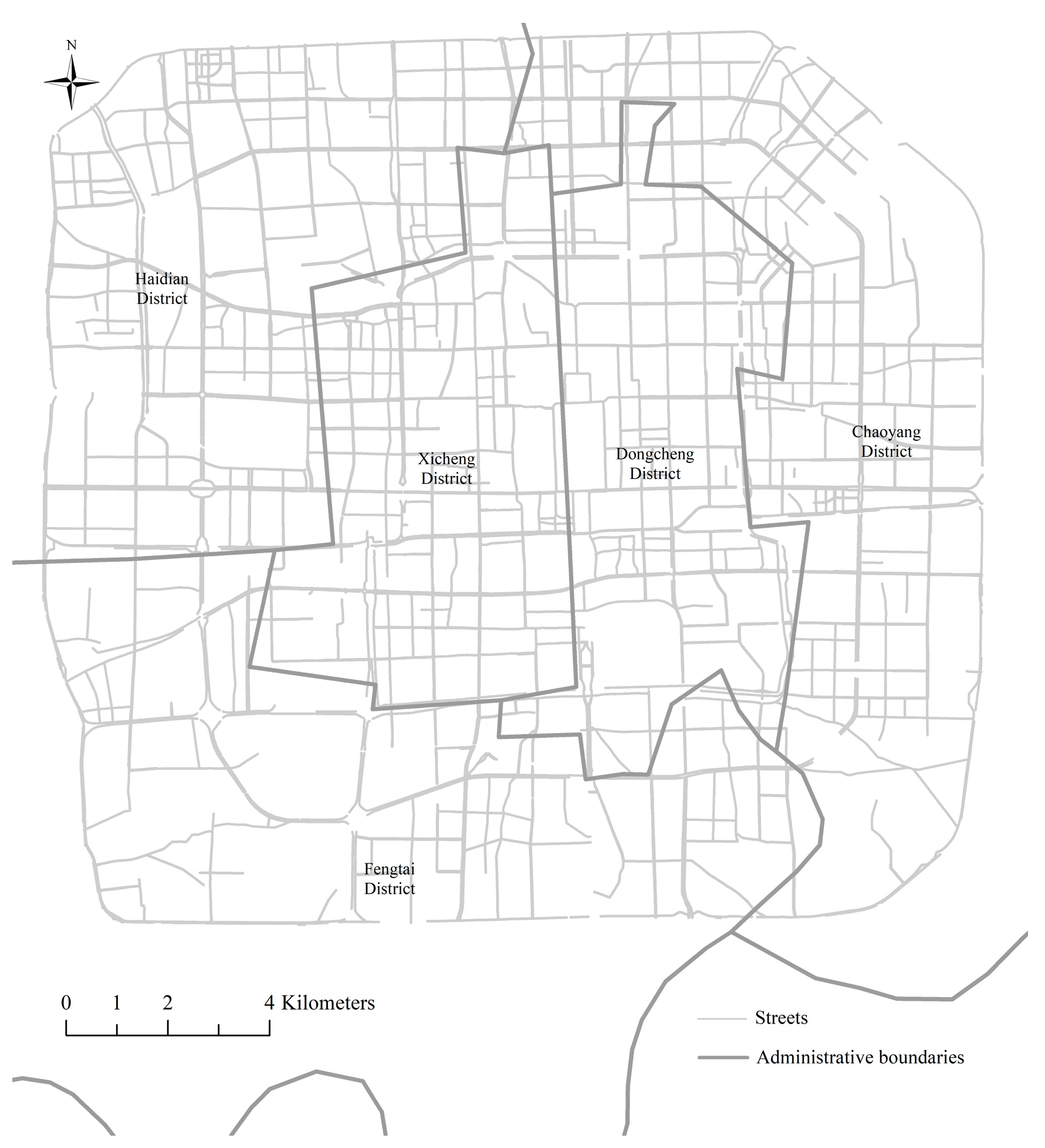
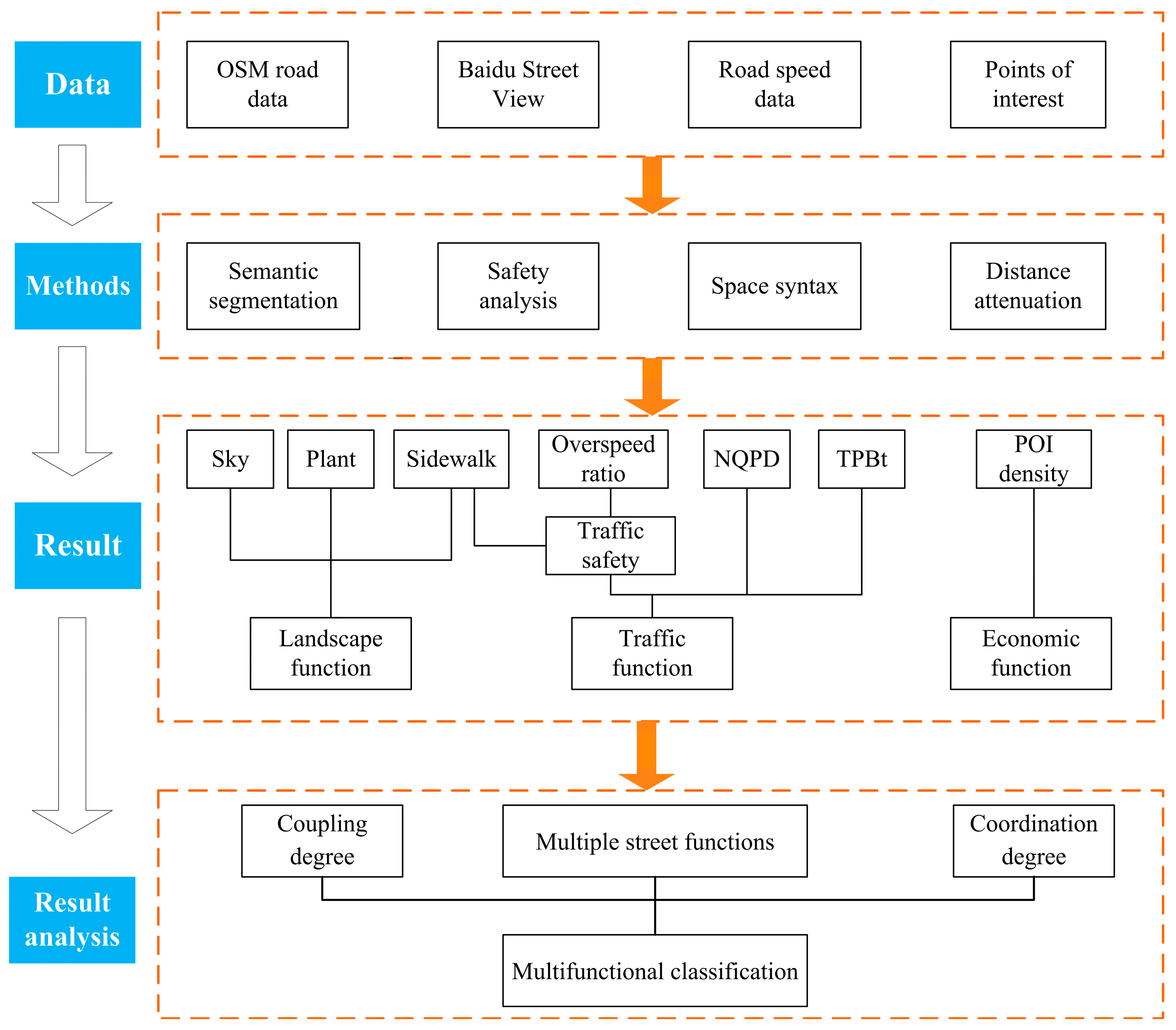
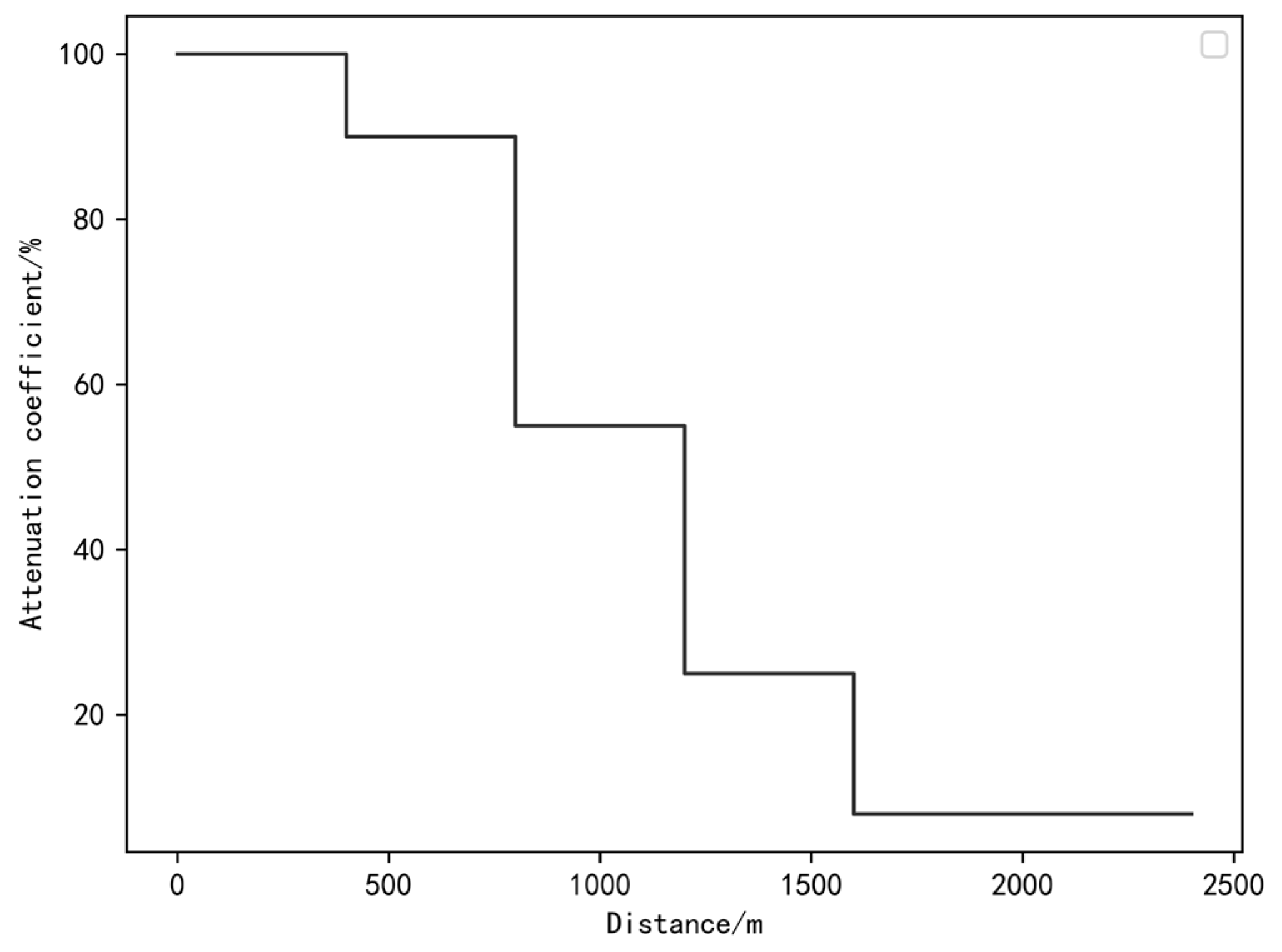


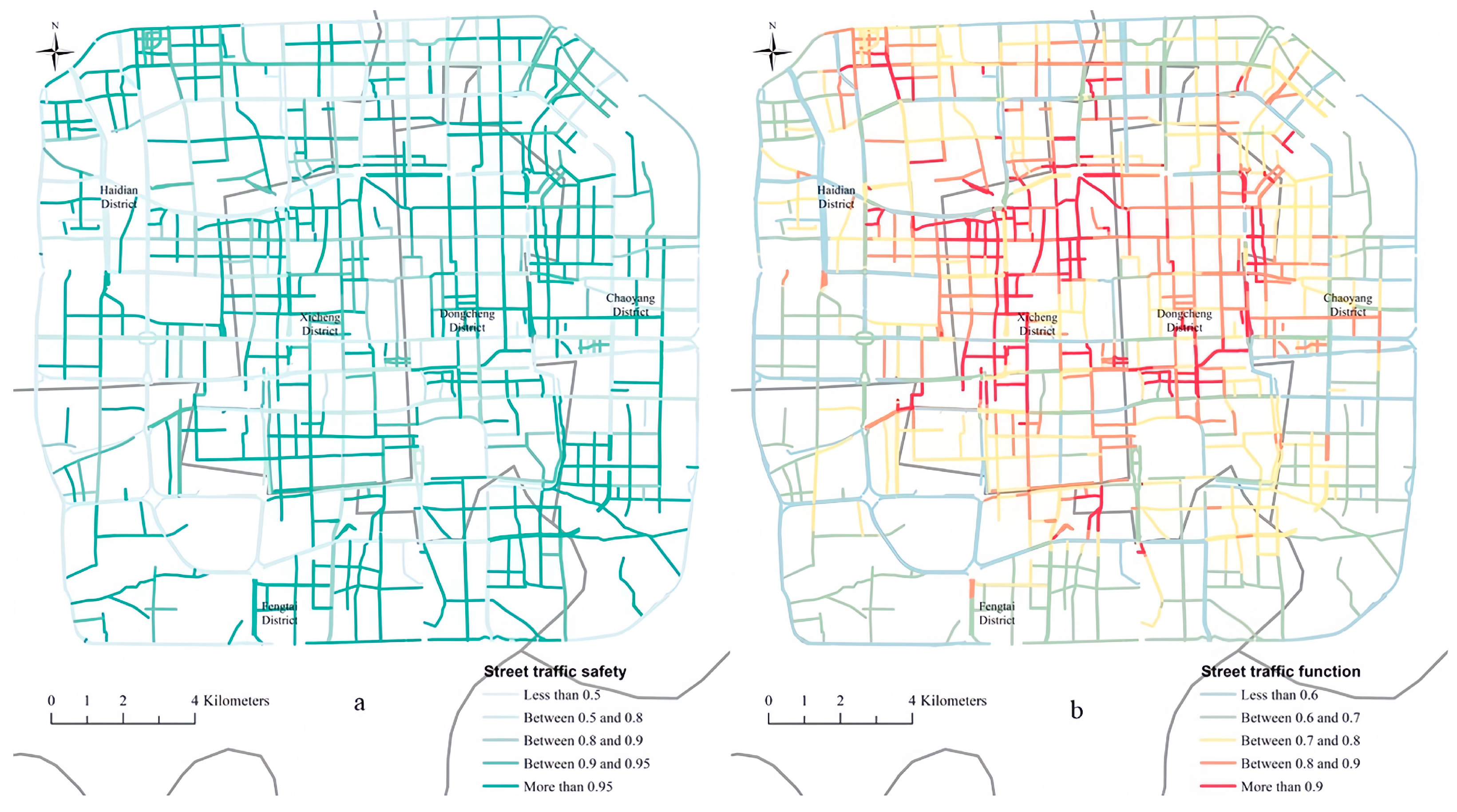
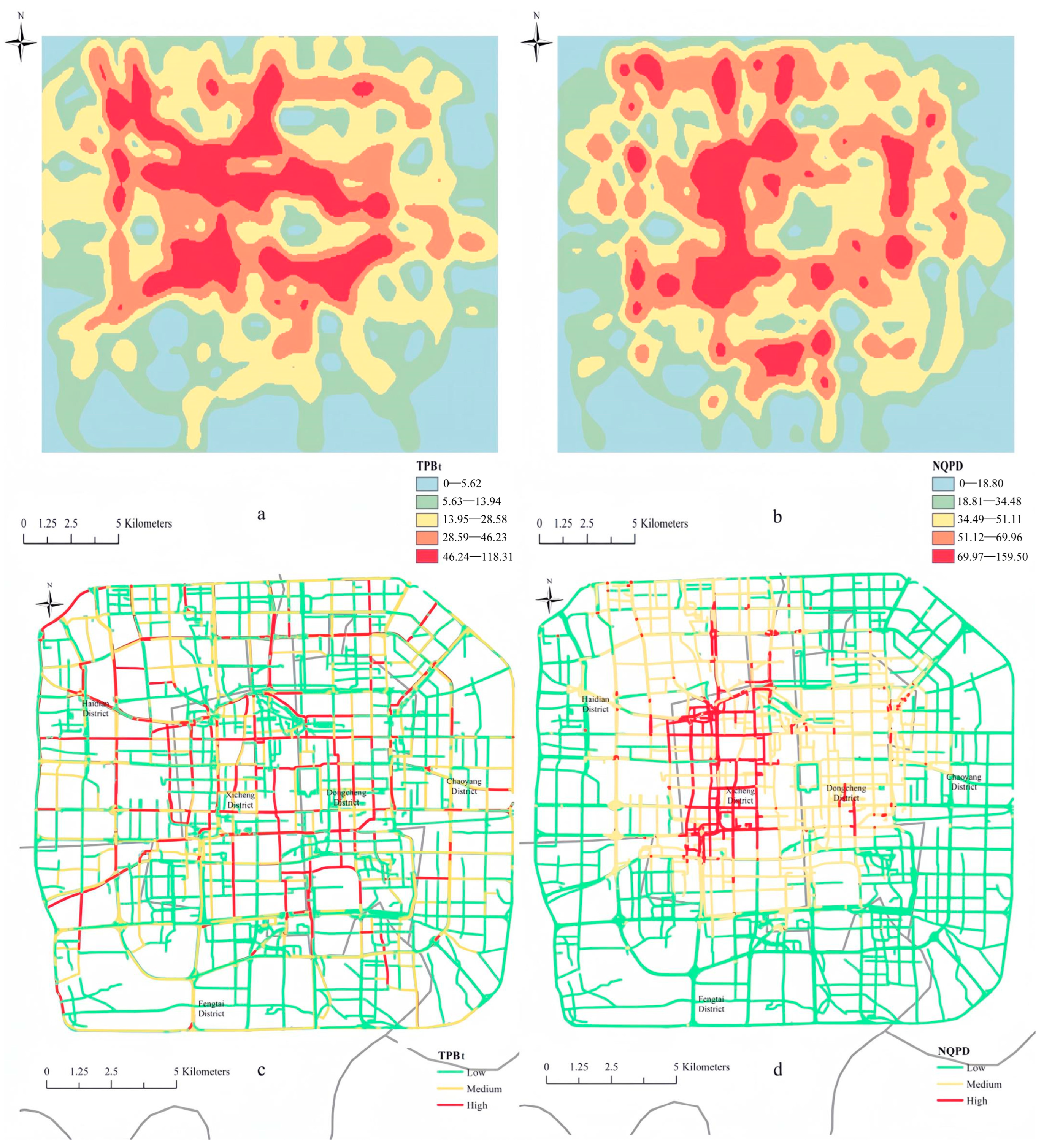
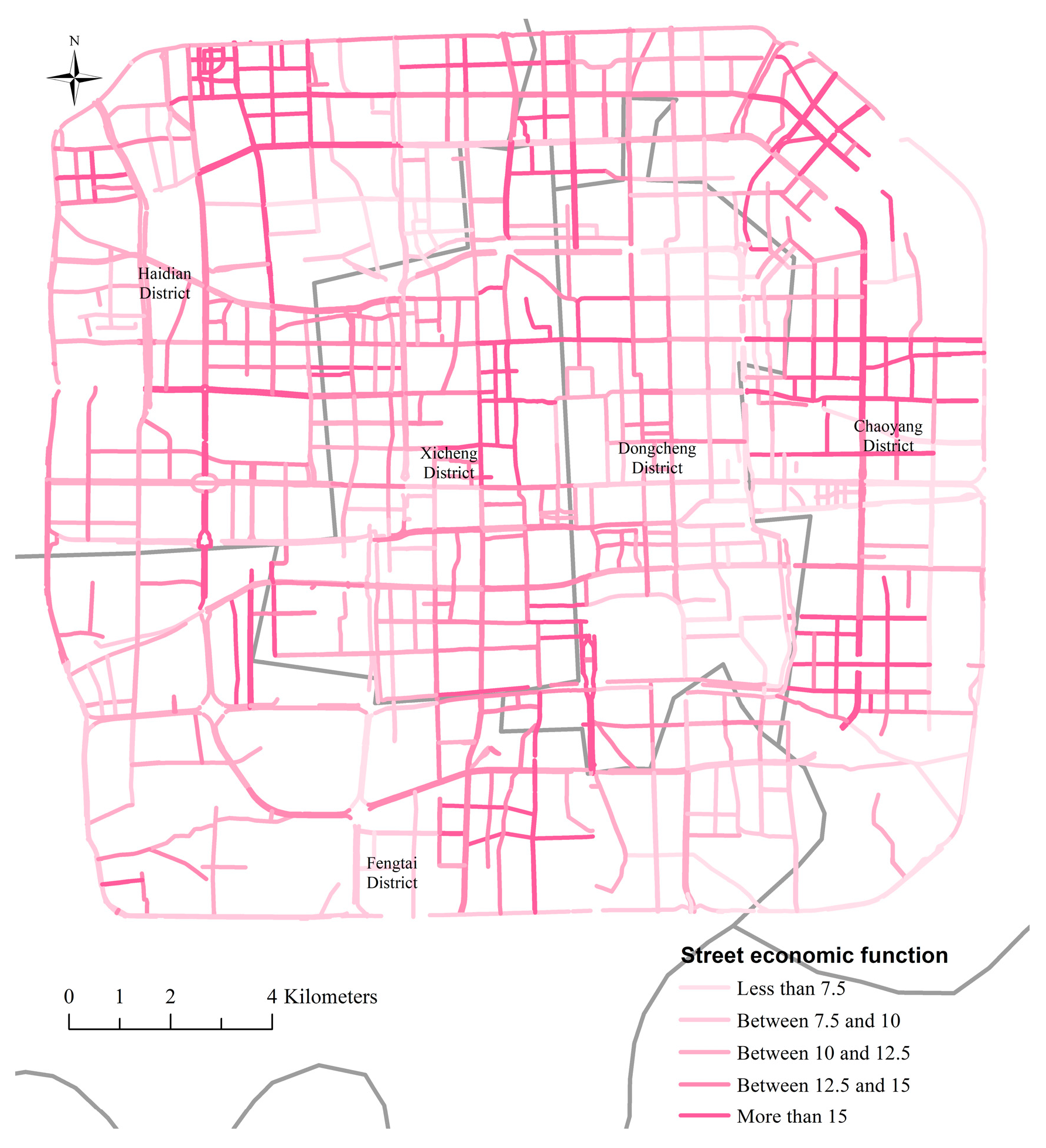
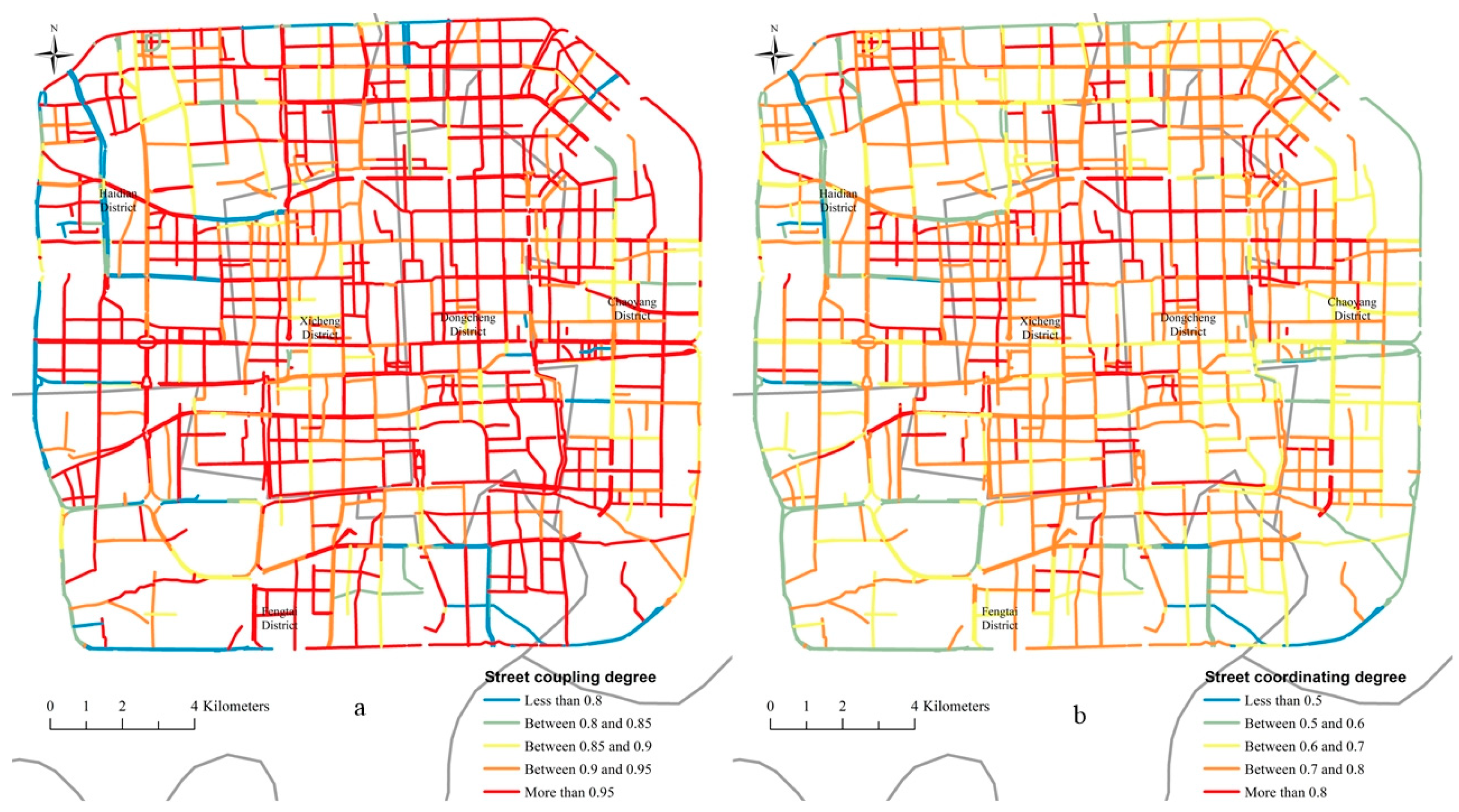

| Type of Facility | Facilities | Attraction Coefficient |
|---|---|---|
| Education | Kindergarten | 0.50 |
| Primary school | 0.50 | |
| Middle school | 0.50 | |
| Health care | General hospital | 0.75 |
| Specialized hospital | 0.25 | |
| Community hospital | 0.25 | |
| Pharmacy | 0.25 | |
| Catering | Small restaurant | 0.75 0.50 0.25 |
| Large restaurant | 0.75 0.50 0.25 | |
| Fast food chain | 0.50 | |
| Bakery | 0.50 | |
| Teahouse | 0.25 | |
| Café | 0.25 | |
| Shops | Supermarket | 1.00 |
| Convenience store | 1.00 | |
| Shopping mall | 0.75 | |
| Bookstore | 0.25 | |
| News kiosk | 0.25 | |
| Exclusive shop | 0.50 | |
| Sports and entertainment | Culture and art | 0.50 |
| Sports venue | 0.75 | |
| Entertainment | 0.50 | |
| Park | 1.00 | |
| Finance | Bank | 0.20 |
| ATM | 0.20 | |
| Station | Bus station | 0.75 |
| Subway station | 1 |
| Multifunctional Type | Functions | Coordination Degree | |||
|---|---|---|---|---|---|
| Landscape | Traffic | Economic | |||
| I Multifunction coordination type | I-1 High | High | High | High | High |
| I-2 Medium | Medium | Medium | Medium | Medium | |
| I-3 Low | Low | Low | Low | Low | |
| II Single-function leading type | II-1 Landscape | Medium | Medium | Medium | Low |
| II-2 Traffic | Medium | Medium | Medium | Low | |
| II-3 Economic | Medium | Medium | Medium | Low | |
| III Dual-function coordination type | III-1 Landscape–Traffic | Medium | Medium | Medium | Medium |
| III-2 Landscape–Economic | Medium | Medium | Medium | Medium | |
| III-3 Traffic–Economic | Medium | Medium | Medium | Medium | |
| Multifunctional Type | Functions | Coordination Degree | Area | |||
|---|---|---|---|---|---|---|
| Landscape | Traffic | Economic | ||||
| I Multifunction coordination type | I-1 High | 0.571~1 | 0.709~1 | 0.758~1 | 0.844–0.939 | 4.52% |
| I-2 Medium | 0.480~0.571 | 0.527~0.709 | 0.621~0.758 | 0.769–0.826 | 2.09% | |
| I-3 Low | 0~0.480 | 0~0.527 | 0~0.621 | 0.591–0.726 | 2.86% | |
| II Single-function leading type | II-1 Landscape | 0.480~1 | 0~0.709 | 0~0.758 | 0.496–0.891 | 24.02% |
| II-2 Traffic | 0~0.571 | 0.527~1 | 0~0.758 | 0.662–0.860 | 20.31% | |
| II-3 Economic | 0~0.571 | 0~0.709 | 0.621~1 | 0.461–0.851 | 15.75% | |
| III Dual-function coordination type | III-1 Landscape–Traffic | 0.480~1 | 0.527~1 | 0~0.758 | 0.729–0.909 | 5.51% |
| III-2 Landscape–Economic | 0.480~1 | 0~0.709 | 0.621~1 | 0.706–0.897 | 11.75% | |
| III-3 Traffic–Economic | 0~0.571 | 0.527~1 | 0.621~1 | 0.739–0.894 | 13.19% | |
| Distinct | Multifunction Coordination Type | Single-Function Leading Type | Dual-Function Coordination Type | Landscape Functions to Be Developed | Traffic Functions to Be Developed | Economic Functions to Be Developed |
|---|---|---|---|---|---|---|
| Dongcheng | 9.86% | 52.61% | 37.52% | 48.36% | 66.34% | 29.79% |
| Xicheng | 9.77% | 48.51% | 41.72% | 61.42% | 48.68% | 28.64% |
| Haidian | 7.08% | 67.16% | 25.77% | 50.07% | 50.87% | 67.16% |
| Chaoyang | 14.55% | 61.49% | 23.97% | 56.53% | 48.26% | 68.93% |
| Fengtai | 5.71% | 67.62% | 26.67% | 35.48% | 62.86% | 64.29% |
| Landscape Function | Traffic Function | Economic Function | ||
|---|---|---|---|---|
| Landscape function | Pearson’s Correlation Coefficient | 1 | 0.47 * | −0.99 ** |
| Significance (two-tailed) | 0.000 | 0.000 | 0.000 | |
| N | 5436 | 5436 | 5436 | |
| Traffic function | Pearson’s Correlation Coefficient | 0.47 * | 1 | 0.164 ** |
| Significance (two-tailed) | 0.000 | 0.000 | 0.000 | |
| N | 5436 | 5436 | 5436 | |
| Economic function | Pearson’s Correlation Coefficient | −0.99 ** | 0.164 ** | 1 |
| Significance (two-tailed) | 0.000 | 0.000 | 0.000 | |
| N | 5436 | 5436 | 5436 |
Disclaimer/Publisher’s Note: The statements, opinions and data contained in all publications are solely those of the individual author(s) and contributor(s) and not of MDPI and/or the editor(s). MDPI and/or the editor(s) disclaim responsibility for any injury to people or property resulting from any ideas, methods, instructions or products referred to in the content. |
© 2023 by the authors. Licensee MDPI, Basel, Switzerland. This article is an open access article distributed under the terms and conditions of the Creative Commons Attribution (CC BY) license (https://creativecommons.org/licenses/by/4.0/).
Share and Cite
Fu, S.; Fang, Y.; Wang, N.; Tong, Z.; Liu, Y. Measuring the Multiple Functions and Tradeoffs among Streets: A New Framework Using the Deep Learning Method. ISPRS Int. J. Geo-Inf. 2023, 12, 486. https://doi.org/10.3390/ijgi12120486
Fu S, Fang Y, Wang N, Tong Z, Liu Y. Measuring the Multiple Functions and Tradeoffs among Streets: A New Framework Using the Deep Learning Method. ISPRS International Journal of Geo-Information. 2023; 12(12):486. https://doi.org/10.3390/ijgi12120486
Chicago/Turabian StyleFu, Shihang, Ying Fang, Nannan Wang, Zhaomin Tong, and Yaolin Liu. 2023. "Measuring the Multiple Functions and Tradeoffs among Streets: A New Framework Using the Deep Learning Method" ISPRS International Journal of Geo-Information 12, no. 12: 486. https://doi.org/10.3390/ijgi12120486
APA StyleFu, S., Fang, Y., Wang, N., Tong, Z., & Liu, Y. (2023). Measuring the Multiple Functions and Tradeoffs among Streets: A New Framework Using the Deep Learning Method. ISPRS International Journal of Geo-Information, 12(12), 486. https://doi.org/10.3390/ijgi12120486





